(Please improve this section by adding common video mixers; their features, and links to useful information. If you add a bullet point, please add it to all entries to maintain uniformity. I.e. if you wanted to add a bullet point on glitch box manufacturers )
Inputs:
- Video: 4x input channels
- Each with 1x BNC and 1x S-Video
- If both are used S-Video will be selected over BNC
- Audio:
- 2x ¼” mono
- 1x RCA
Outputs:
- aaa
Features:
- aaa
Notes:
- Self-feedback
- Is it capable of self-feedback, if so, describe the signal chain.
Links:
Inputs:
- Aaaa
Outputs:
- aaa
Features:
- aaa
Notes:
- Self-feedback
- Is it capable of self-feedback, if so, describe the signal chain.
Links:
- https://www.youtube.com/watch?v=PgloHB616mU
- http://resource.datavideo.com/specs/Datavideo_SE-800.pdf
- http://resource.datavideo.com/specs/Datavideo_HS-800.pdf
Effect type: Video Effects
Inputs:
- 4 Composite RCA
- 1 S-video
Outputs:
- 1 Composite RCA
- 1 Composite RCA Preview out
- 1 S-video
Features:
- aaa
Notes:
- Self-feedback
- Is it capable of self-feedback, if so, describe the signal chain.
Links:
A.k.a Blaupunkt DVM-1000
Inputs:
- Aaaa
Outputs:
- aaa
Features:
- aaa
Notes:
- Self-feedback
- Is it capable of self-f no eedback, if so, describe the signal chain.
Links:
- Classic Gear: Panasonic WJMX-10
- Classic Gear: Panasonic WJMX-10 pt2
- https://www.manualslib.com/manual/999585/Panasonic-Wj-Mx10.html
- Luma key mod: https://matiaswilkman.blogspot.com/2009/11/wj-mx10-luma-key-mod.html
- Glitch Guild member Blank says: ““Luma mod” is a modification that allows you to use the video signal from the second channel as an insert of the superimpose function. In other words, mixer gains capability for full-fledged luma keying using two video signals. Modification does not result in a loss of any significant functionality. Originally, the WJ-MX10 allows you to select background color of superimpose function in two ways: using the “back colour” button and selecting the color with the knob, or by using the “white” button. Once modification is made, the “white” button turns it on. Selection of any background color is still possible using “back colour” and the selection knob.”
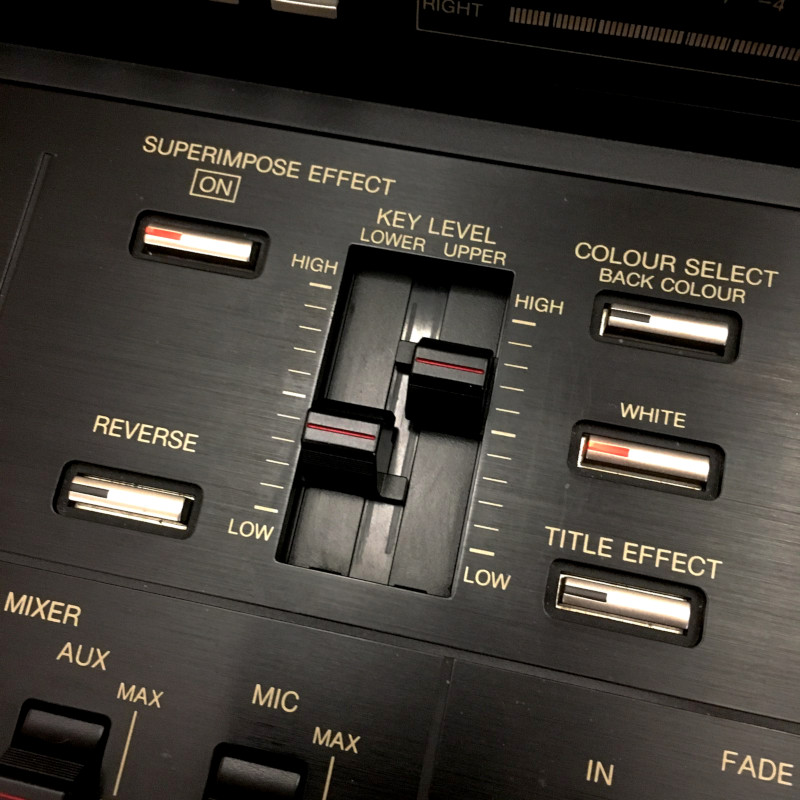
Inputs:
- Aaaa
Outputs:
- aaa
Features:
- aaa
Notes:
- Self-feedback
- Is it capable of self-feedback, if so, describe the signal chain.
Links:
- https://www.manualslib.com/products/Panasonic-Wj-Mx-12-3965988.html
- https://www.audioservicemanuals.com/p/panasonic/panasonic-wj/12249368-panasonic-wj-mx-12-service-manual
Inputs:
- Aaaa
Outputs:
- aaa
Features:
- aaa
Notes:
- Self-feedback
- Is it capable of self-feedback, if so, describe the signal chain.
Links:
Inputs:
- Four BNC or S-Vid
Outputs:
- aaa
Features:
- Downstream key
- Two independent effects busses
Notes:
- Self-feedback
- Is it capable of self-feedback, if so, describe the signal chain.
- Preview out and DSK can be used for feedback chains
Links:
- https://www.manualslib.com/manual/305832/Panasonic-Wj-Mx50.html
- Panasonic WJ-MX50 Video Mixer
- Video Mixer Guides: panasonic mx-50
Note: If you are looking for the Panasonic WJ-AVE3, it is in the Video Effects section.
Inputs:
- Aaaa
Outputs:
- aaa
Features:
- aaa
Notes:
- Self-feedback
- Is it capable of self-feedback, if so, describe the signal chain.
Links:
- Circuit bending details: https://lushprojects.com/videobend/#wjave5
- WJ-AVE5 Time Base Correction Flavor | Glitchart.com
- https://elektrotanya.com/panasonic_wj-ave5_sm.pdf
Typical issues:
- Channels turning black&white.
This problem is linked to aging components and affects many Panasonic mixers. Sometimes, just an adjustment of CT1/CT2 trimmers on the main board is required to restore proper operation. In other cases adjacent electrolytic capacitors have to be replaced. In the situation documented below, the defect disappeared after replacing capacitor C88 (channel B). After desoldering old capacitors it is necessary to clean the pcb - electrolyte leaking from damaged cap is conductive and may cause a short circuit resulting in missing color.
To reach the underside of the mainboard, shielding cage must be desoldered & disassembled.
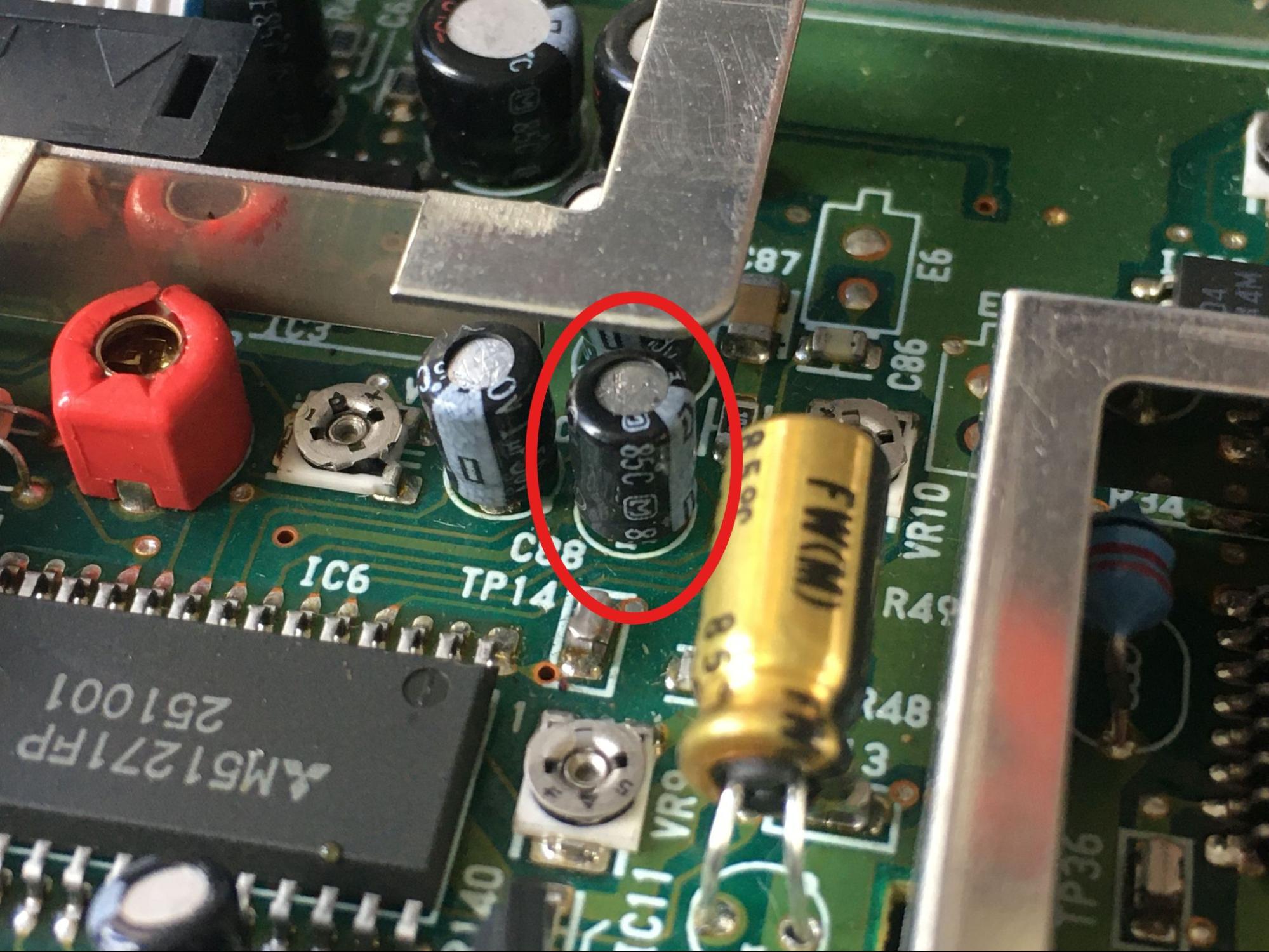

Note: If you are looking for the Panasonic WJ-AVE3, it is in the Video Effects section.
Inputs:
- Aaaa
Outputs:
- aaa
Features:
- aaa
Notes:
- Self-feedback
- Is it capable of self-feedback, if so, describe the signal chain.
Links:

Inputs:
Outputs:
Features:
Notes:
- Self-feedback
- Is it capable of self-feedback, if so, describe the signal chain.
Links:
- Aaa

Edirol was a sub-brand of Roland. So this mixer looks similar to some other Roland offerings.
Inputs:
- 4 Composite RCA
- 2 S-video
Outputs:
- 2 Composite RCA
- 1 S-video
- 1 Composite RCA Preview out
Features:
- Some midi control
- BPM sync
Notes:
- This was released under the Edirol subdivision of Roland; and will be marked Edirol.
- Self-feedback
- Is it capable of self-feedback, if so, describe the signal chain.
- Manual says Copyright 2003
Links:
- Cat Full of Ghosts Abelton Live Plugin - https://www.etsy.com/listing/1578389148/max4live-video-mixer-plugin-bundle
- Classic Gear: EDIROL V4
- Video Mixer Guides: Roland Edirol v-4


A classic 2-channel video mixer. Built like a tank, with robust BNC connectors.

Inputs:
- 4 x (Priority) S-Video (Y/C) - DIN
- 7 x Composite - BNC
- 2 x VGA (selectable) - 15-pin dsub
- MIDI - DIN
Outputs:
Master
- 2 x Composite - BNC
- 1 x S-Video (Y/C) - DIN
Preview (For on screen menu and input monitoring)
- 1 x Composite - BNC
Monitor
- 8 x Composite - BNC
Other
- MIDI Out/Thru
Features:
- Some midi control
- BPM sync
- S-Video (Y/C) and VGA conversion to Composite via monitor outs
- Individual fades per channel
- T-bar can be rotated in any direction with just 4 easily accessible screws
Notes:
- IMPORTANT: If you pick one of these up, be sure to do a factory (p)reset via the menu, as it is possible to mess with the channel colours in the menu
- Self-feedback
- Is it capable of self-feedback, if so, describe the signal chain.
- RGBHV to Component cable - https://www.amazon.com/gp/product/B001O8C6HM
Links:
- https://proav.roland.com/global/products/v-8
- Owner’s Manual
- Cat Full of Ghosts Abelton Live Plugin - https://www.etsy.com/listing/1578389148/max4live-video-mixer-plugin-bundle
- Classic Gear: EDIROL V8
- Edirol/Roland V8 Video Mixer Feedback Effect Demo
- Edirol/Roland V8 Video Mixer Feedback Effect Demo, Part 2
- Edirol/Roland V8 Video Mixer Feedback Effect Demo, Part 3
- Edirol/Roland V8 Video Mixer Feedback Effect Demo, Part 4

This is much more than just the V-4 with a built-in touch screen. The software is more mature; and supports HDMI.
Inputs:
- Inputs 1-3 are Composite BNC or HDMI (480p/59.94)
- Input 4 can be used as ONE of:
- Composite
- S-video
- HDMI (1080-59.94p)
- RGBHV (up to 1920x1200/60hz) (via 15 pin D-sub aka VGA connector)
- Component with an additional breakout adapter (resolution?) (via 15 pin D-sub aka VGA connector)
Outputs:
- 1 Composite BNC
- 1 HDMI
- 1 HDM Preview Out (480 / 59.94p)
- Class Compliant USB Video at 720x480
- 1 Analog RGB / Component (via 15 pin D-sub aka VGA connector).
- 640 x 480, 800 x 600, 1024 x 768, 1280 x 768, 1280 x 1024, 1366 x 768, 1400 x 1050, 1600 x 1200, 1920 x 1200 The refresh rate for RGB format is 60 Hz at all resolutions when set to NTSC. When set to PAL, the rate is 50 Hz at underlined resolutions and 75 Hz at others.h
- The Interlaced/non-interlaced format for the HDMI output determines the type of output on the 15 pin D-sub connector.
- When an interlaced format is selected (on HDMI); Component is output on the DSUB15 connector.
- When a non-interlaced format is selected (on HDMI); RGB is output on the DSUB15 connector.
- Audio out on HDMI and USB (16bits/48 kHz / linear PCM)
Features:
- Midi IN, MIDI Out/Through. Some MIDI Control
- BPM sync
- Does this have upscaling?
Notes:
- Self-feedback
- Yes, although it’s complicated by the limited number of outputs.
- RGBHV to Component cable - https://www.amazon.com/gp/product/B001O8C6HM
- The V-4EX isn’t a native HD switcher. CH 1–3 are SD only (480i/576i) and the mixer de-interlaces + frame-syncs everything to an internal 480/576p bus. The HDMI output format (480/576p, 720p, 1080p) is just a final-stage scaler. So the lowest latency is when you match the bus: feed SD into CH 1–3 and set MAIN OUT to 480/59.94p (or 576/50p). Forcing 720/1080 adds an extra frame at the output. CH4 (HDMI) also costs ~1 more frame than CH1–3. Net: CH1–3 ≈ 2 frames, CH4 ≈ 3 frames at 60p. Using “only one input” doesn’t bypass the frame sync/scaler—the pipeline is always engaged.
Links:
- Roland Pro A/V - V-4EX | 4-Channel Digital Video Mixer with Effects
- Cat Full of Ghosts Abelton Live Plugin - https://www.etsy.com/listing/1578389148/max4live-video-mixer-plugin-bundle
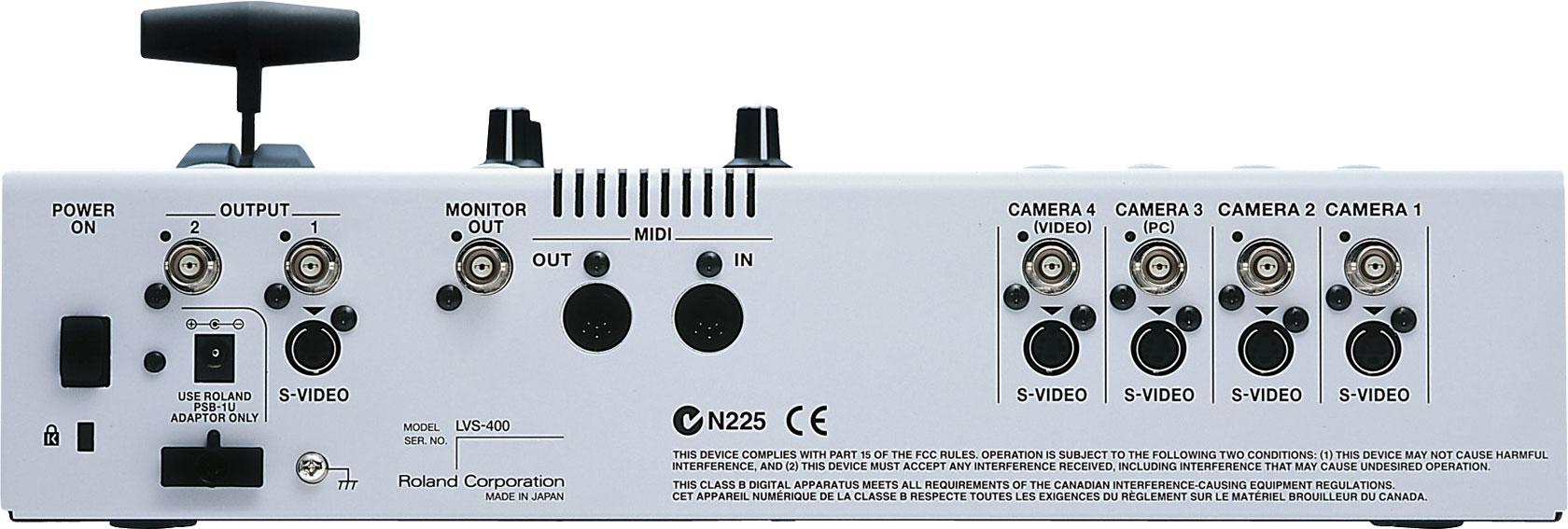
Inputs:
Outputs:
Features:
Notes:
- Self-feedback
- Is it capable of self-feedback, if so, describe the signal chain.
Links:
- Aaa
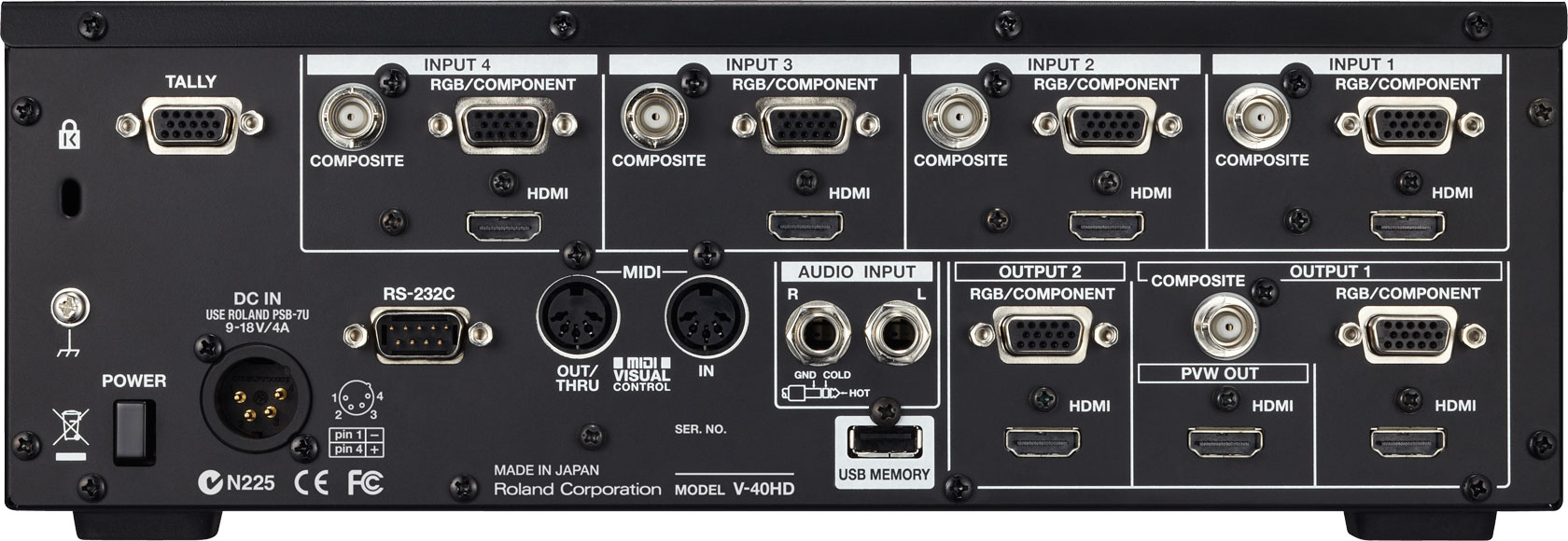
Inputs:
Outputs:
Features:
- Much fewer effects than the V-8 or the V-4EX, seems like
Notes:
- Self-feedback
- Is it capable of self-feedback, if so, describe the signal chain.
Links:

Inputs:
- 4 x S-Video
- 4 x SD BNC
- 4 x HD Component BNC
- 4 x RGB VGA
- 5-din midi in
- Remote DB9
Outputs:
- SD output [S-Video, BNC]
- Preview OSD out [BNC]
- 4 x SD Channel monitor outs [BNC]
- HD Component BNC 1
- HD Component BNC 2
- HD Component Preview
- RGB VGA 1
- RGB VGA 2
- RGB VGA preview
- Tally SD
- Tally HD
Features:
- 2 Bus mixer. 4 SD channels and 4 HD channels. SD channel output has it’s own HD channel making for 5 total channels. I english good?
Essentially this is a SD mixer that runs into a HD mixer. It’s awesome.
Notes:
Max VGA output resolution is smaller than max Composite output resolution.
Self-feedback: 4 WAYS TO FEED!
- S-Video out to S-video In
- SD Bnc out to SD BNC in
- HD BNC out to HD BNC In
- RGB VGA out to RGB VGA in
Due to the 2 mixer bus this unit has, SD feedback can run in-series to the HD channel feedback
Links:
- https://proav.roland.com/global/products/v-440hd/
- https://static.roland.com/assets/media/pdf/v440hd_manual.pdf
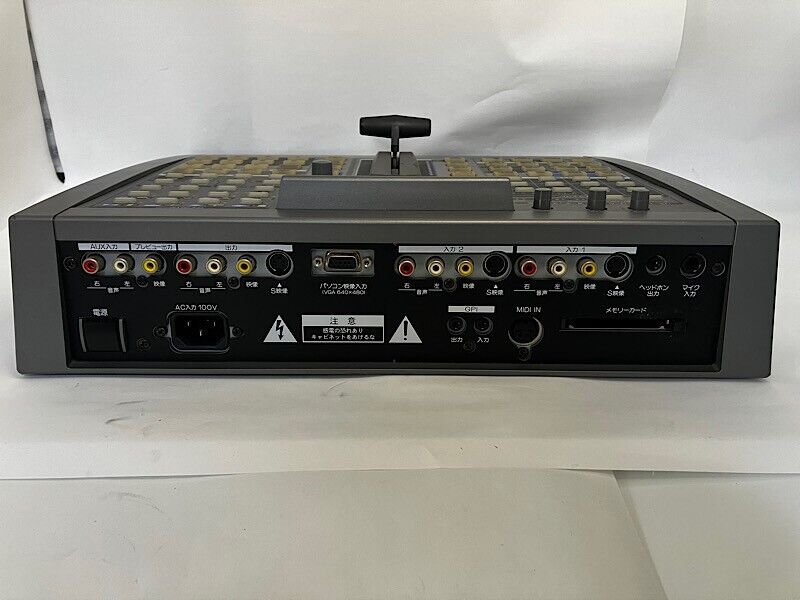
Inputs:
- aaa
Outputs:
- aaa
Features:
- aaa
Notes:
- Manual is copyright 1998
- Article says this was the first Roland video gear shipped to USA. It seems more likely to find japanese variants.
Links:
- https://archive.org/details/RolandV-5VideoCanvas
- Roland V-5 User Manual? : r/VideoBending
- https://www.soundonsound.com/music-business/history-of-roland-part5

Inputs:
- Aaaa
Outputs:
- aaa
Features:
- aaa
Notes:
- Self-feedback
- Is it capable of self-feedback, if so, describe the signal chain.
Links:
- https://proav.roland.com/global/support/by_product/vr-3/updates_drivers/
- https://archive.org/details/manualsbase-id-222525
- https://static.roland.com/assets/media/pdf/vr3_manual_e02.pdf

Inputs:
- Aaaa
Outputs:
- aaa
Features:
- aaa
Notes:
- https://proav.roland.com/global/support/by_product/vr-3ex/owners_manuals/
- https://static.roland.com/assets/media/pdf/VR-3EX_eng03_W.pdf
- Is it capable of self-feedback, if so, describe the signal chain.
Links:
- aaa
Inputs:
- Aaaa
Outputs:
- aaa
Features:
- aaa
Notes:
- There have been several examples of the Sima SFX series popping up rebadged, presumably as a white-label product. Le’ts collect info on those here. If the SFX-11 was the first one to support PAL, then the overseas ones are probably PAL?
- Sima SFX-9, SFX-10, SFX-11 are very similar. Anecdotally it seems the SFX-10 was a redesign of the SFX-9, and the SFX-11 adds NTSC/PAL switching.
- Self-feedback
- Is it capable of self-feedback, if so, describe the signal chain.
Links:
Inputs:
- Aaaa
Outputs:
- aaa
Features:
- aaa
Notes:
- Sima SFX-9, SFX-10, SFX-11 are very similar. Anecdotally it seems the SFX-10 was a redesign of the SFX-9, and the SFX-11 adds NTSC/PAL switching.
- Self-feedback
- Is it capable of self-feedback, if so, describe the signal chain.
Links:
- https://www.bhphotovideo.com/c/product/250919-REG/Sima_SFX9_SFX_9_Video_Mixer_with.html/specs
- https://www.manualslib.com/products/Sima-Sfx-9-6054764.html
- https://www.manualslib.com/products/Sima-Sfx-9a-641877.html
Inputs:
- Aaaa
Outputs:
- aaa
Features:
- aaa
Notes:
- Sima SFX-9, SFX-10, SFX-11 are very similar. Anecdotally it seems the SFX-10 was a redesign of the SFX-9, and the SFX-11 adds NTSC/PAL switching.
- Self-feedback
- Is it capable of self-feedback, if so, describe the signal chain.
Links:
Inputs:
- Aaaa
Outputs:
- aaa
Features:
- aaa
Notes:
- 12VDC 1.25A Center Positive power.
- Sima SFX-9, SFX-10, SFX-11 are very similar. Anecdotally it seems the SFX-10 was a redesign of the SFX-9, and the SFX-11 adds NTSC/PAL switching.
- Self-feedback
- Is it capable of self-feedback, if so, describe the signal chain.
Links:
- https://www.bhphotovideo.com/c/product/675850-REG/Sima_SFX_11_SFX_11_Digital_Video_Mixer.html/specs
- https://www.ebay.com/itm/335640725909
Inputs:
- Aaaa
Outputs:
- aaa
Features:
- aaa
Notes:
- 18VDC .8A center positive power
- Self-feedback
- Is it capable of self-feedback, if so, describe the signal chain.
Links:
Inputs:
- 4 RCA Composite
- 4 S-video
Outputs:
- 1 RCA Composite
- 1 S-video
- 1 RCA Composite Preview Out
- effects: chroma key, negative, mosaic, strobe, b&w, posterise, solarise
- PIP
Notes:
- Serial control - https://scanlines.xyz/t/video-toolkit-3-0/1230/11
- Power: 12v AC @1.2A barrel plug
- This Reddit thread notes that, despite the units being labeled for AC power, DC power adapters seem to work. https://www.reddit.com/r/videosynthesis/comments/10txix9/videonics_mx1_ac_power/
- Self-feedback
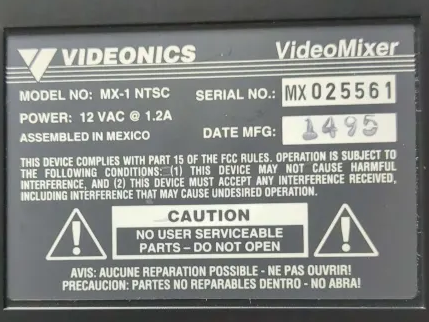
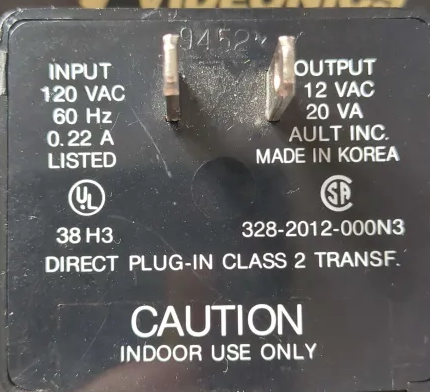
- Yes, you can use the Composite or S-video to self-feedback. You can use the S-video to self-feedback, while using the the remaining Composite output for your display.
Links:
- MX-1 Service Manual - https://archive.org/details/videonics_mx-1_sm
- https://scanlines.xyz/t/videonics-mx-1-tbc/962/12
- video mixer guides: videonics mx-1

Inputs:
- 4 Composite RCA
- 4 S-video
Outputs:
- 2 Composite RCA
- 2 S-video out
- 1 Composite RCA Preview out
Features:
- aaa
Notes:
- It is confirmed that there are two versions of the MX-3000 NTSC, that list different power requirements. Both are DIN6.
- DIN6 +5vdc @5.0A, +7vdc @.6a, -7vdc @.4a
- DIN 6 +5vdc @ 4.5A, +10vdc @ 0.4A, -10VDC @ 0.4A
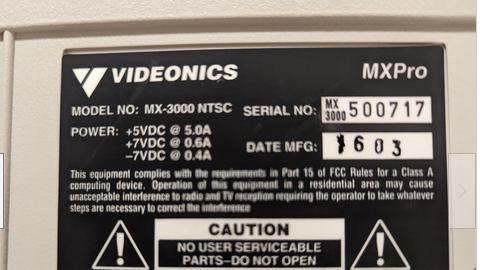

- PWRS-0020-01 / SPU41-012C power supply for MX-3000 NTSC
- https://www.reddit.com/r/videosynthesis/comments/10u787z/got_this_videonics_mxpro_recently_does_anyone/
- I believe this connector is a DIN 8. CUI Devices SD-80 is an example. https://www.cuidevices.com/product/resource/sd.pdf
- https://www.digikey.com/en/products/detail/cui-devices/SD-80/97003
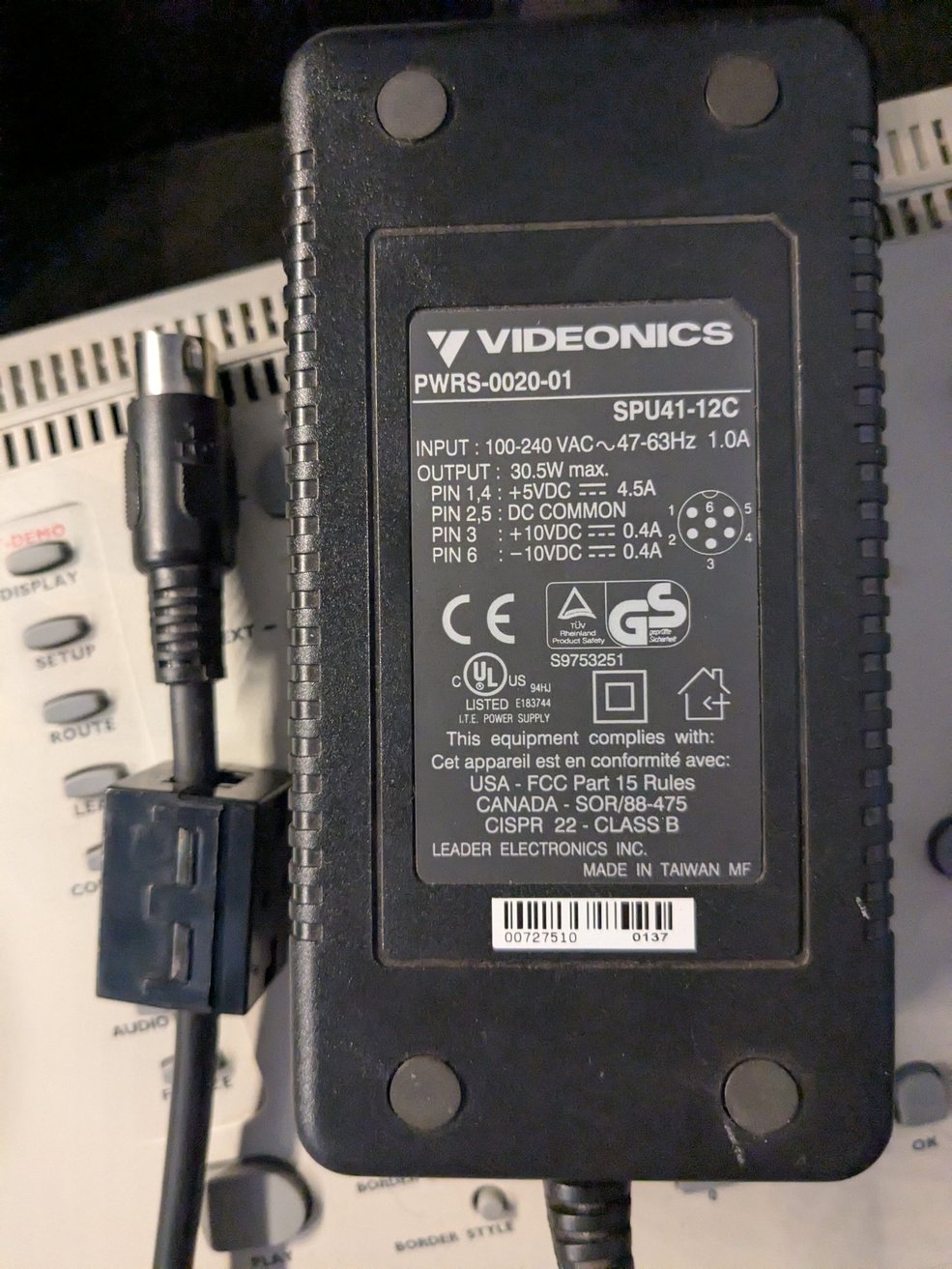
- Self-feedback
- Is it capable of self-feedback, if so, describe the signal chain.
Links:
- https://www.manualslib.com/manual/239748/Videonics-Mxpro.html
- https://www.videomaker.com/article/c5/3497-mx-1-video-mixer-is-a-product-for-the-mass-audience/
- Videonics MXPro Digital Video Mixer Quick-Start Video
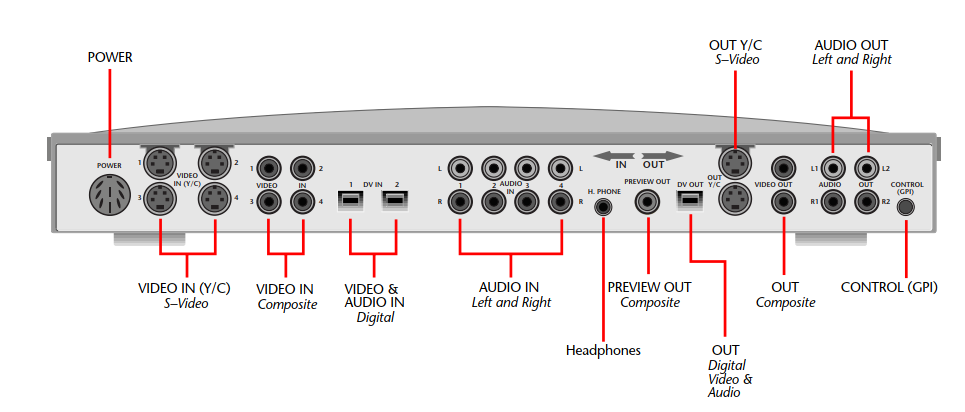
Inputs:
- 4 S-Video
- 4 Composite RCA
- 2 Firewire (IEEE1394)
Outputs:
- 1 Firewire (IEEE1394)
- 2 Composite RCA
- 2 S-video
- 1 Composite RCA preview Out
Features:
- aaa
Notes:
- Uses a non-standard power supply.
- Back of device lists requirements as +5VDC @ 5.0A; +7VDC @0.6A; -7VDC @0.4A
- Note, from the manual in the graphic, the MXProDV appears to use an DIN 8 power connector.
- Not sure the provenance of this image, what does it go to?
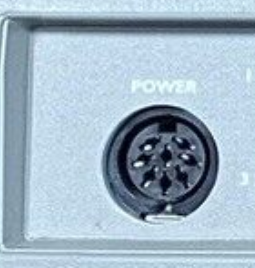
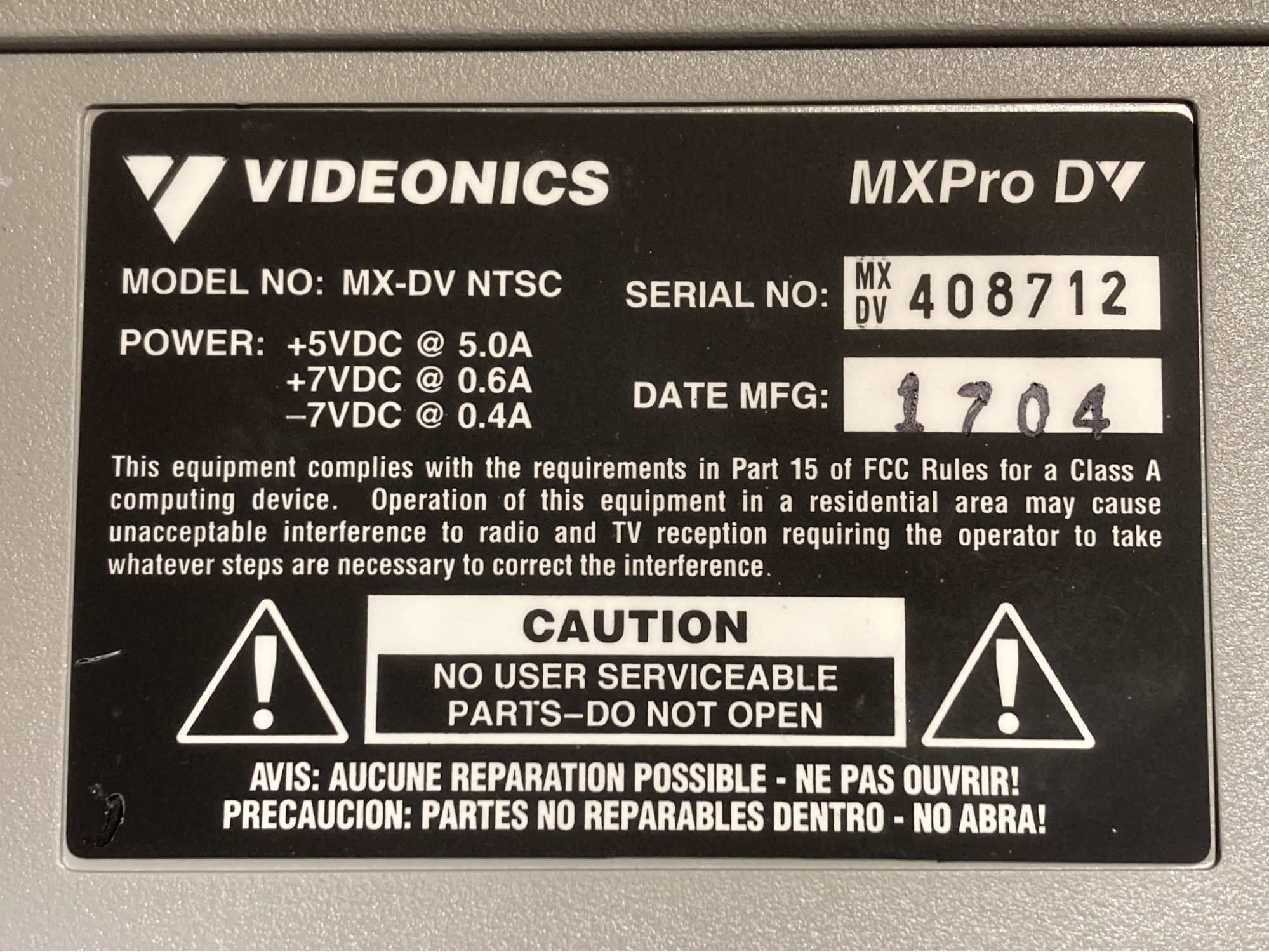
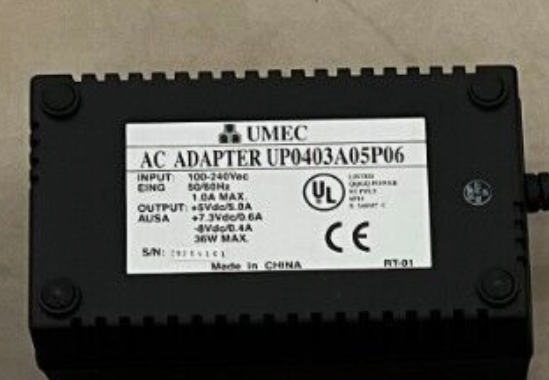
- Self-feedback
- Is it capable of self-feedback, if so, describe the signal chain.
Links:
- https://www.manualslib.com/manual/239749/Videonics-Mxpro-Dv.html
- https://www.videomaker.com/article/7568-review-videonics-mxprodv-digital-video-mixer/
- https://www.videomaker.com/article/c5/3497-mx-1-video-mixer-is-a-product-for-the-mass-audience/
The Focus Enhancements MX-4 appears to be a rebadged Videonics MXPRO.
Inputs:
- Aaaa
Outputs:
- aaa
Features:
- aaa
Notes:
- Power is a 12VDC barrel jack
- Self-feedback
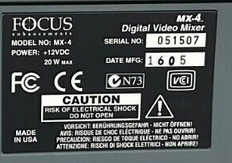
- Is it capable of self-feedback, if so, describe the signal chain.
Links:
- https://www.manualslib.com/manual/358262/Focus-Mx-4.html
- https://ia904600.us.archive.org/22/items/focus-enhancements-fs100-3-0firmware/Product%20Info/Video%20Production/Data%20Sheets/MX_Line_DS_10Jan06_US.pdf
- https://www.ebay.com/itm/256376633542 (Power Supply shown)
- https://www.videomaker.com/videonews/2004/08/focus-enhancements-releases-new-video-mixers/
- https://web.archive.org/web/20100610092849/http://www.focusinfo.com:80/support/downloads.asp

The Focus Enhancements MX-4DV appears to be a rebadged Videonics MXPRO DV model; however, note that the rear panel is very different, including 4 DV inputs, versus the 2 dV inputs on the Videonics MXPRO DV, and also ethernet. Also it appears some software features were removed compared ot the Focus Enhancements MX-4 non DV.
Inputs:
- Aaaa
Outputs:
- aaa
Features:
- aaa
Notes:
- Self-feedback
- Is it capable of self-feedback, if so, describe the signal chain.
Links:
- https://www.manualshelf.com/manual/focus-enhancements/mx-4dv/user-guide-english.html
- https://www.manualslib.com/manual/239741/Focus-Mx-4-Dv.html#manual (Features removed compared to the MX-4 non DV)
- https://www.newegg.com/focus-enhancements-mx-4-dv/p/N82E16830995085 (First available date 2007)
- https://web.archive.org/web/20100610092849/http://www.focusinfo.com:80/support/downloads.asp